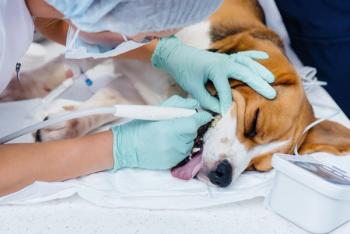
Just Ask the Expert: Is there a role for melatonin in dogs and cats with IMHA?
This hormone is already embraced by some veterinarians for various conditions. Dr. Christopher Byers explores whether there is an indication for immune-mediated hemolytic anemia.
(Getty Images)Q. Can melatonin be used to treat immune-mediated hemolytic anemia (IMHA) in veterinary patients?
A. Melatonin is a hormone produced in the pineal gland of the brain. In people, melatonin secretion is influenced by the amount of light to which the body is exposed. Thus, traditionally it is thought to help regulate our normal waking and sleeping cycles. For example, melatonin levels increase in the evening and decrease in the early morning. Because of this effect, many people take oral melatonin supplements to treat disorders such as insomnia, jet lag and seasonal affective disorder. Many emergency veterinarians use melatonin to help control their sleep patterns when working overnight shifts.
Melatonin has been used in limited capacity in veterinary medicine. Veterinary dermatologists frequently prescribe this supplement for patients living with alopecia X. Some internal medicine specialists will initially use a combination of melatonin and hydroxymatairesinol (HMR) lignans to treat occult hyperadrenocorticism, a syndrome biochemically characterized by normal serum cortisol concentrations with elevated androgens (i.e. estradiol, 17-OH progesterone, progesterone, androstenedione) post-ACTH stimulation.
The use of melatonin for immune-mediated diseases comes from extrapolation from human literature. One study reported the successful control of refractory idiopathic thrombocytopenic purpura in three human patients after melatonin administration.1 This same group of researchers also documented resolution of severe hemorrhage due to refractory idiopathic thrombocytopenic purpura with melatonin administration.2 Current evidence suggests melatonin may be a helpful non-immunomodulatory therapeutic adjunct for patients with immune-mediated thrombocytopenia (ITP) because it promotes the fragmentation of megakaryocytes, thus increasing the number of circulating platelets.
Literature also suggests melatonin may modulate cytokine production, including interleukin-1 (IL-1), IL-2, IL-6, IL-13 and interferon alpha. One study showed melatonin decreased IL-6 and IL-13 production, as well as antagonized specific autoantibodies in a murine model of systemic lupus erythematosus (SLE).3 Another study showed melatonin administration appeared to rescue hematopoiesis in mice treated with anti-cancer compounds through promotion of endogenous release of granulocyte/macrophage colony-stimulating factor and opioid cytokines.4 Melatonin appears to directly affect inflammation and immune cells, as well as enhance hematopoiesis.
It is for these reasons some have advocated its use in the treatment of other immune-mediated conditions, including immune-mediated hemolytic anemia (IMHA), immune-mediated polyarthropathy (IMPA), and SLE. Anecdotally there are multiple reports of successful management of dogs and cats with various immune-mediated conditions with the use of a multitude of immunomodulatory protocols and concurrent melatonin. However, I cannot recommend melatonin as a single-agent therapy for these conditions.
Melatonin may promote glucocorticoid resistance. Glucocorticoids are commonly used as first-line therapeutic agents in patients with immune-mediated conditions since this class of drug suppresses peripheral T helper (Th) cell responses. Uniquely, T cells may lose their sensitivity to glucocorticoids, complicating medical management. In people, one theory to explain reduced T cell sensitivity to glucocorticoids is the effect of IL-2. In people, lymphocytes are an important physiological source of melatonin, as they can synthesize and release large quantities of melatonin. Lymphocyte-derived melatonin appears to be directly linked to the release of IL-2. IL-2-induced glucocorticoid resistance through stimulation of opioid cytokines in T lymphocytes and/or direct inhibition of glucocorticoid receptor expression has been documented in people.5 Should a similar process of glucocorticoid resistance occur in dogs and cats, concurrent use of cyclosporine may be of logical benefit. Cyclosporine inhibits IL-2 and interferon gamma production through calcineurin inhibition.
As veterinarians, we still have a tremendous amount to learn about melatonin. Unquestionably, research regarding its use in our patients with immune-mediated diseases is needed.
References
1. Todisco M, Rossi N. Melatonin for refractory idiopathic thrombocytopenic purpura: a report of 3 cases. Am J Ther 2002;9:524-526.
2. Todisco M, Casaccia P, Rossi N. Severe bleeding symptoms in refractory idiopathic thrombocytopenia purpura: a case successfully treated with melatonin. Am J Ther 2003;10:135-136.
3. Zhou LL, Wei W, Si JF, et al. Regulatory effect of melatonin on cytokine disturbances in the pristane-induced lupus mice. Mediators Inflamm 2010. Epub.
4. Maestroni GJ, Covacci V, Conti A. Hematopoietic rescue via T-cell-dependet, endogenous granulocyte-macrophage colony-stimulating factor induced by the pineal neurohormone melatonin in tumor-bearing mice. Cancer Res 1994;45:2429-2432.
5. Walker KB, Potter JM, House AK. Interleukin 2 synthesis in the presence of steroids: a model of steroid resistance. Clin Exp Immunol 1987;68:162-167.
Newsletter
From exam room tips to practice management insights, get trusted veterinary news delivered straight to your inbox—subscribe to dvm360.




